
AICS and Lynx SF 10x42M Scope review by John Dunn:
In the arcane world of military and tactical sniping, the rifles built by Accuracy International (AI) have a well-earned reputation for accuracy and reliability. A family of five rifles systems designed by the company is used for sniper and counter-snipering activities by police agencies and the military forces of more than 40 countries around the world.
All the rifles consist of a purpose-built (both) action, mated to a specially designed chassis system enclosed by a twp-piece plastic shell that comprises the stock.
 |
AICS stocked Remington 700 on the bench with the Harris bipod attached. |
The subject of this review is a variation of the Accuracy International Chassis System (AICS) an upgrade kit designed to accept short-action Remington 700 rifles in.308 Winchester. AN AICS kit is also available for long-action Remingtons in .300 Winchester and .338 Lapua Magnums. It comes as no surprise that Remington Rifles would be chosen as first commercial marque to be mated with an ACIS Upgrade Kit given their reputation for out-of-box accuracy. Kits for other makes will be available at a later date.
Central to the AICS Upgrade Kit is the anodized aluminum alloy chassis that is the back bone of the system. It consists of three distinct components that are glued and pinned together to provide a solid platform on which the rifle is mounted.
In the middle of the chassis is the heart of the system - a slab–sided, self centring bedding block that incorporates a snug slot for the recoil lug, a magazine well with a push forward lever release and a slot for the Remington trigger group. A five-round, single column magazine is supplied with each rifle and 10-shot magazines are available for .308 Winchester.
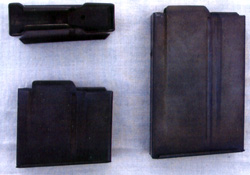 |
5- and 10- shot magazine for the .308 AICS kit. |
By any other name, the top of the block is really nothing more than an elongated V-block - hense its ability to self centre the action. The lower sides of the round Remington receiver are the only contact points the action has with the chassis. A pair of Allen head screws supplied with the kit secures the action to the block. Connections for both Harris and A1-type bipods are also incorporated, as are sling swivel attachment points, one on both sides of the forearm tip.
The rear of the chassis is made from solid stock and has an elongated L shape. It accepts an adjustable cheek piece and butt-pad. These allow the buttstock to be tailored to individual requirements in terms of fit and length of pull. Like the forearm, two swing swivel connection points are provided – one on both sides at the heel of the stock. A webbing sling specifically designed for the stock is available as an accessory.
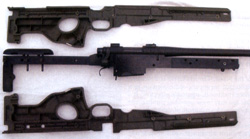 |
Internal chassis with stock sides removed |
Magazine well in AICS stock with 5-shot magazine in place |
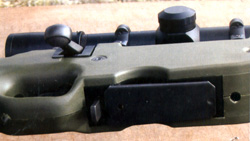 |
The stock consists of two plastic shells (sides) that fit over and around the chassis. These incorporate a moulded triggerguard and ambidextrous pistol grip. Internally ribbed for strength, they’re secured to each other by eight screws, six of which pass straight threw the chassis. Washers and nuts for the screws are moulded into the right and left shells of the stock respectively. Stock colours available are black and drab olive. With the stock screwed into place the barrel is completely free floating.
The review kit consisted of an olive stock and Remington was in stock-standard factory configuration.
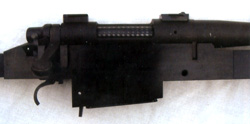 |
Centre section of the chassis with the Remington in place, showign the magazine well and release lever and the slot for the recoil lug. This section of the AI chassis is, essentially, an elongated V-block |
LYNX SF 10x42M Scope
Also supplied for evaluation in conjunction with the AICS kit was a lynx SF10x42M scope. This is a new scope in the Lynx line-up and was originally designed for South African military service shooters competing at Bisley. The SA military liked the look of the scope and, subsequently used it on their 40-calibre NTW bolt-action armour-piercing rifle.
Part of the Lynx Military range, the scope has a 30mm tube and, not surprisingly a Mil Dot reticle. While I have no real problems with this type of reticle, it ahs always struck me as being more suitable for target and/or tactical usage rather than hunting. The shooter must know how to use it properly to make the most of what it offers. A good explanation of how the reticle works is given in the Lynx website.
The scope has three turrets on the saddle of the scope. The left turret is a focusing knob that serves the same purpose as a more traditional, adjustable objective. It’s fast and easy to use providing parallax-free images with a minimum of movement.
The windage and elevation knobs were designed to military specs and provide easy finger adjustment – each click having a nominal value of ¼ moa.
The scope was mounted on the Remington action using Lynx two-piece bases and Lynx QD lever mounts.
Test Firing
With the scope mounted, the cheekpiece and buttpad were adjusted to suit my requirements and the rifle was taken to my range for test firing.
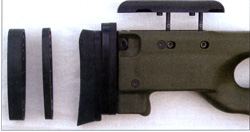 |
Adjustable cheekpiece and butt on the ACIS stock. |
For someone like myself, who is a hunter rather than a range shooter, the stock felt a little bulky at first – comfortable enough to handle and swing though definitely not your average sporting rifle. Given its target/tactical design that’s not surprising. Even so, the set-up could b used in the paddock if required – preferably as a sit-and-wait rifle rather than one you could carry all day.
Ammunition used for testing consisted of PMC 150-grain as well as Winchester Power Point loads in 150- and 180-grain weights – all that I had in my ammunition stock at the time. Each ammo type was used to shoot three five shot groups at 100m. Average results were 37mm, 31mm and 41mm respectively – with some groups smaller and others obviously larger, though all stayed within 50mm. The 180-grain loads painted lower on the targets that the 150-grain loads – as you’d have to expect.
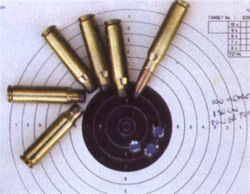 |
The best 5 shot group with the ACIS/Remington 700 combo measured 17mm at 100m using Winchester 150-grain factory loads. |
After a thorough cleaning, I checked all screws for tightness, cinched them up as required and went back to the bench with a Harris bipod attached to the forearm and the butt resting on a sandbag. I then proceeded to re-shoot my original course of fire.
Groups with all three types were similar, averaging between 32 and 50mm. The best group, shot with the Winchester 150-grain load, was just 17mm so, at some stage, I must have been holding my mouth right. That said, I must admit I couldn’t duplicate that particular group – though it was nice to know the rifle could produce the goods when everything was just right.
A lesson learnt during the session was that Harris bipod must be securely attached to the stock – if it isn’t, accuracy will suffer.
At 200m, all three lots of ammo grouped between 52 and 64mm. Those are excellent results with factory ammo and I expect that a dedicated target shooter using quality handloads would better them.
Overview
I believe big bore and long range target shooters will find the system very useful, and it’s my guess that’s where the bulk of AICS stocked rifles will eventually be seen. The AICS stock was comfortable to use both off the bench and prone with a bipod attached – it’s performance undoubtedly enhanced by the adjustable cheekpiece and buttpad.
That the review rifle shot so well came to no surprise – Remington rifles generally do. Being mated to the rigid, V-block bedding of the AICS was no handicap and the use of quality ammunition would have helped as well.
The ACIS might not be everyone’s cup of tea but those who can use the reliability and accuracy the system offers will find it well worth looking at.
Review rifle and AICS kit supplied courtesy of Gault Pty Ltd.
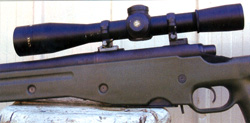 |
Lynx SF 10x42M scope set up on the Remington action in Lynx QD lever mounts on the parallex adjustment knob. |